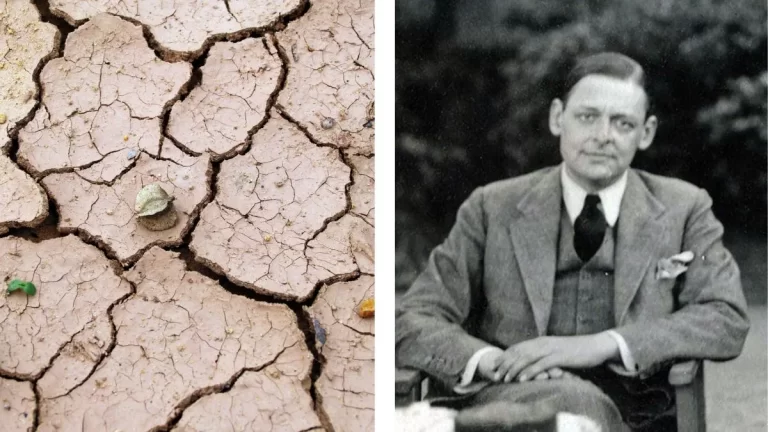
Only nine years before the Wasteland was first published, Rabindranath Tagore had won the Nobel Prize for literature.
By Preeti Hay
In 1922, exactly a hundred years ago, a literary landmark was born in the field of modern poetry. T.S. Eliot’s The Wasteland first appeared in The Dial after winning the same magazine’s Poetry award. Instantly, it found success, taking the world of literature by storm. In 1948, it won the Nobel Prize.
Only nine years before the Wasteland was first published, Rabindranath Tagore had won the Nobel Prize for literature. At the onset, we may not see an obvious correlation between these two monumental works written in completely different parts of the world. But when we look closer, many allusions and inspirations are revealed in Eliot’s work that point to major influences from India and Indian spirituality.
Oriental Influences
In her essay titled T. S. Eliot’s The Waste Land: A Perspective on Indian Thoughts, Dr. Rajani Sharma points out “the Indian sensibility with its Christian Intent” that makes this poem unique.
To understand the alchemical congruence of the East and the West that went into this globally resounding poem, one has to understand the context of the times it was written in and that of the influences over the poet.
The title reflects the utter barrenness of the human condition that caused a spiritual fog in the post-World War world. Eliot reckoned that such degradation borne of lust, greed and anger would lead to a state of annihilation. So what was the solution?
In the mid-nineteenth century, Indian thought became a subject of interest to many western writers. When Eliot arrived at Harvard, it became a famous center for Oriental studies. His mentors included Irving Babbit and George Santayana, who were instrumental in his developing an interest in Indian scripture and philosophy. He went on to enroll in Indic courses where he started studying Pali and Sanskrit as part of his interest in Hinduism and Buddhism.
Eliot said, “Long ago I studied the ancient Indian languages, and while I was chiefly interested at that time in philosophy, I read a little poetry too, and I know that my poetry shows the influence of Indian thought.”
A Universal Solution
Through these comprehensive influences, Eliot concurred that the conundrum of the mechanical spiritual death could not be solved only by the West, and needed a universal solution.
It is no surprise then that the headings for two of the five sections of the poem are derived from Indian sources, alongside the symbolism of the Grail Legend and the Fisher King. In a true modernist style, the poem features abrupt changes of speakers, place and time, portraying the dissonance that is emblematic of its subject matter. It also interweaves scenes from contemporary British life into the labyrinth of these myths and higher thoughts.
The Five sections
The first section, called ‘The Burial of the Dead’, talks about the rejuvenation of modern humanity with the drop of rainwater. The poem says:
April is the cruelest month, breeding
Lilacs out of the dead land, mixing
Memory and desire, stirring
Dull roots with spring rain.
Drawn from the Buddhist text, Dhammapada, this thought can be traced back to Gautam Buddha, who suggests growing a Boddhi tree in his heart by becoming spiritually aware of his existence.
The next section, A Game of Chess, is a contemporary exploration of the degradation of marriage and sex in modern society.
The third section, called, The Fire Sermon, is derived directly from a sermon of Lord Buddha. This section focuses on fighting temptations on the path and overcoming desire to lead to nirvana. Here, Eliot draws not only from Buddha’s idea of ascetism, but also from St. Augustine.
The next section titled, Death by Fire, builds on the idea of the fire sermon. Here, the self is transformed from a gross being into an enlightened being. The Vedic concept of tapa is touched upon here.
In his essay called The Upanishad in the Wasteland, G. Nageshwara Rao writes, “Drought throughout Eliot’s poetry is metaphor for despair, doubt and need for spiritual certainty. Just as water is taught by thirst, the need for nourishing faith is taught by a restless state of doubt in which one can neither stand or lie nor sit.”
The last section, The Word of the Thunder, is completely based on the Upanishads. The Brihadaranyaka Upanishad alludes to Prajapathi, the creator, talking to his three offsprings—Devtas, Demons and Men: reiterating the cardinal virtues of Damyata (Restraint), Datta (Charity) and Dayadhvam (Compassion). The voice of the thunder ends on a positive note when the poem ends with the command, “Shantih, Shantih, Shantih.” Eliot wishes peace upon all, even the wastelanders who are gripped by fear.
In a letter to Bertrand Russell, Eliot described the last section as, “not only the best part but the part that justifies the whole.” This statement is not only revealing but extremely powerful because it sums up the immense power of the Vedas and Upanishads that form the structural matrix of the poem. While this is not an Indian poem per se, its strong message of the power of Indian philosophy still resonates a hundred years on. And perhaps will, for many more centuries.
_______________
Courtesy: India Currents (Published on December 16, 2022) Reproduced with permission of India Currents